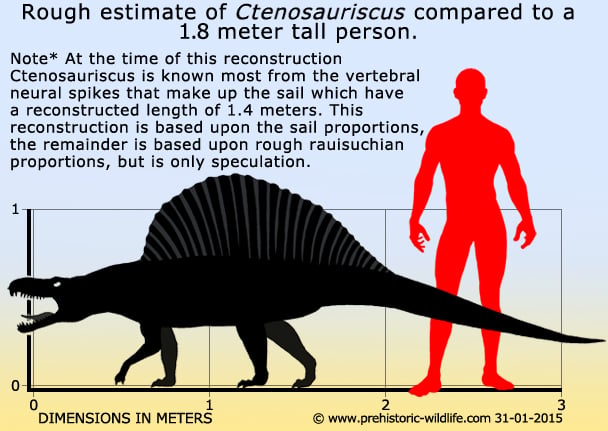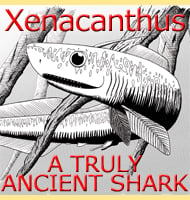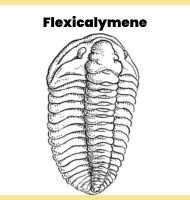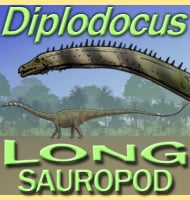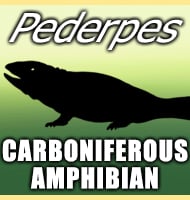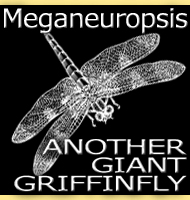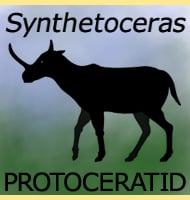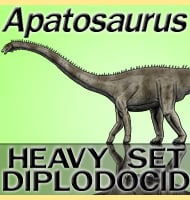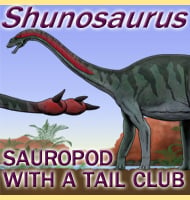In Depth
Ctenosauriscus is the type specimen of the Ctenosauriscidae, a group of sail backed rauisuchian archosaurs that also include others such as Arizonasaurus. Ctenosauriscidae however is only known from post cranial remains that reveal it had a large sail on its back. Like in related reptiles, this sail was supported by the enlarged neural spines of the vertebrae. The neural spines in the anterior half of the sail curved slightly forwards, while the posterior half curved slightly backwards. Altogether Ctenosauriscus possessed the largest known back sail in its group while also being one of the first members of the Ctenosauriscidae to enter the fossil record.
It was once considered that the tall neural spines were thought to have been to absorb the stresses involved in walking upon two legs however this explanation is now considered highly unlikely. First off the only bipedal reptiles known to have enlarged neural spines are dinosaurs like Spinosaurus and Acrocanthosaurus and here it’s certain that the neural spines did not become enlarged for this purpose. Additionally there are other related rauisuchians that have similar back structures yet also remain quadrupedal. Finally the very position of the sail would have shifted the centre of gravity further forward, making a bipedal posture even less likely.
Sails are often thought to have been for the purpose of thermoregulation, the idea being that a larger surface area enables a faster heat exchange with the surrounding environment to either warm up or cool down the animal. While possible, the neural spines that support the sail in Ctenosauriscus are quite robust, and the structure itself may have been for more than temperature regulation. It’s plausible that the sail may have been a fat reserve for storing excess fat.
Rauisuchians like Ctenosauriscus appear in the early Triassic, only a few million years after the biggest single extinction event in the planets history, even bigger than the one that ended the dinosaurs. Animals that could adapt to harsher living conditions would have had an advantage over those that could not, and a fat hump, which may or may not have also helped with temperature regulation as well as even display would have allowed animals equipped with this feature to more easily survive.
As mentioned above, the sail in Ctenosauriscus is so far the largest known in the group, but more importantly it was already well established in what is currently the first known genus to exist. The ancestor (or ancestors) that led to this development may have started adapting several million years earlier at the time of the Permian-Triassic extinction event. Further fossils from around this time would be needed to confirm this however, and until this time it remains only a theory.
Further Reading
– Ungel�ste Probleme der Stammesgeschichte der Amphibien und Reptilien. – Jahreshefte des Vereins f�r vaterl�ndische Naturkunde in W�rttemberg 118/119:293-325. – O. Kuhn – 1964. – Ctenosauriscus koeneni (v. Huene) und der Rauisuchier von Waldshut – Biomechanische Deutung der Wirbels�ule und Beziehungen zu Chirotherium sickleri Kaup. – Stuttgarter Beitr�ge zur Naturkunde, Serie B (Geologie und Pal�ontologie) 261: 1–18. – K. Ebel, F. Falkenstein. F-O. Haderer & R. Wild – 1998. – The Sail-Backed Reptile Ctenosauriscus from the Latest Early Triassic of Germany and the Timing and Biogeography of the Early Archosaur Radiation. – PLOSone – Richard J. Butler, Stephen L. Brusatte, Mike Reich, Sterling J. Nesbitt, Rainer R. Schoch & Jahn J. Hornung – 2011.
